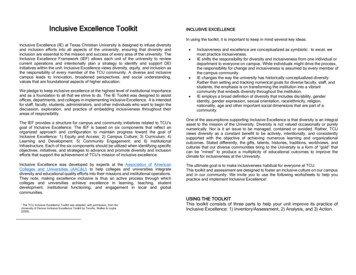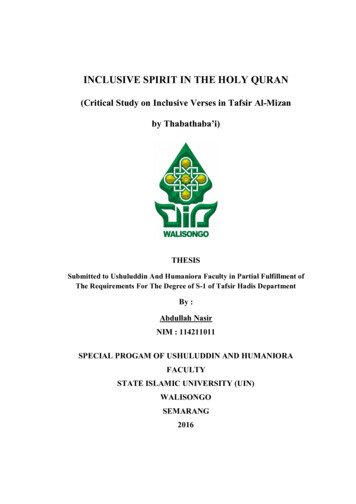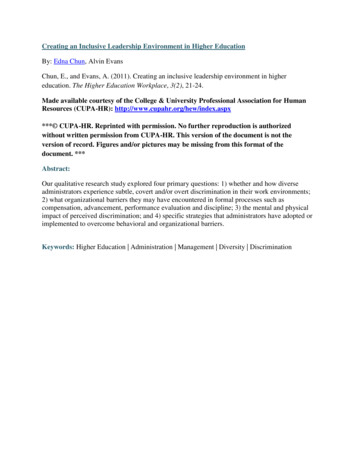
Transcription
The Program Of All-inclusive Carefor the Elderly (PACE):Improving the Care of Older Adults at RiskforNursing Home PlacementTangi McCoy, Chief Executive Officer, MPA, LNHAKim Henderson, Chief Financial Officer, CPA, MBAPeter DeGolia, Medical Director, MD, CMD
Disclosures We have no financial or ethical conflicts of interest to disclose. Tangi McCoy is the CEO of McGregor PACE Kim Henderson is the CFO of the McGregor Organization toinclude, PACE, 2 Nursing Homes, Assisted Living Facilities,Independent Apartments Dr. DeGolia is the McGregor PACE Medical Director and one of3 PACE primary care physicians. He is a Professor of FamilyMedicine at the Case Western Reserve University School ofMedicine in Cleveland, Ohio. He is Board Certified in FamilyMedicine, Geriatric Medicine, and Hospice/Palliative Medicine.
AgendaWhat is PACE? History Participant Eligibility ServicesThe PACE Revenue Model Current statistics CensusWhy PACE The Problem What makes PACE unique Case Studies
What is PACE? Program for All-Inclusive Care For the Elderly Coordinates and provides all preventive, primary, acute and longterm care services Primary care delivered through (2) PACE Centers and (1) alternativelocation Interdisciplinary care management team meets daily, disciplinesinclude: Provider, RN, OT, PT, MSW, RD, Transportation, Activities,Day Center Manager, Center Assistant, HomeCare Coordinator Regulated by Centers for Medicare and Medicaid Services (CMS)and Ohio Dept. of Aging (ODA) More than 40 affiliated service providers/partnership in our network
Historical Origins1971On Lok in San Francisco,California1986 – 1994Successful CMSDemonstration ProjectFormed in response to community concernfor the older adults in Chinatown2000RWJ and HartfordFoundations FundPACE ExpansionInitiativeFederal / State /Local Partnershipwith specific rulesand regulations
McGregor PACE History199820102011McGregor PACE’spredecessor,Concordia CarefoundedMcGregor assumesConcordia Caresponsorship, caring for167 ParticipantsMcGregor PACE is ableto actively enrollparticipants239 PACE Centers in 32statesMcGregor PACE hasalmost 600 seniors inCuyahoga county20182019
PACE is a PARTNERSHIP between the FederalGovernment, (ODA) the State Government, (CMS) and alocal Sponsor (McGregor PACE) Center forMedicare andMedicaidServices (CMS) 32 State partners 122 SponsoringOrganizations 239 PACECenters 50,000 participants 100% neednursing homelevel of care 95% live in thecommunity 5% live in anursing home
Program Essentials4 Basic enrollment criteria Must meet nursing home level of care55 years or olderLive in Cuyahoga CountyLiving safely in the community at the time of enrollment Cannot live in an institutional setting (i.e. hospital, nursing home)State-based nursing home level of care criteria – (Ohio) Requires 24 hour supervision, OR 2) dependent in IADLs plus assistance in 1 ADL plus medication management, OR 3) dependent in IADLs plus assistance in 2 or more ADLs
Program Essentials IADL ADL(Instrumental activities of daily living)(Activities of Daily Living) Preparing meals Shopping Housekeeping Laundry Med Administration Transportation Eating Bathing Dressing Toileting Mobility Grooming
McGregor PACE Services Adult day carePrimary and specialist physician servicesCase management and social workPhysical, Occupational and Speech TherapyInpatient hospitalizationPharmacy (Medicare part D plan)Home support - homecare nursing; safetyEmergency room coverageCover all Medicare & Medicaid servicesTransportation
McGregor PACE Care SitesSenior Health & Wellness Center12,079 square ft220 participantsEmery Road22,212 square ft220 participants12
Transportation
Basic Revenue ModelThree main revenue streams: Medicare - Risk-adjusted, per member per monthcapitated payment from Medicare 2,700 PMPM Medicaid – fixed monthly payment regardless of living incommunity or nursing facility 2,900 PMPM Medicare Part D - pharmacy benefits included in PMPMpayment 900 PMPMManaged Care Model: surplus from healthier participantsoffsets deficit from those more needy
McGregor PACEHistorical Average Census get15
McGregor PACEHistorical Nominal Operating Margin ,000- 1,634 1,231( 271) 507 3,5492015201620172018(5,000)2014RevenueExpenses 1,2872019BudgetNominal Operating (Deficit) / Surplus16
Successful Program Attributes Physician commitment to business model Sufficient local need to maximize census Interdisciplinary team management Community recognition and support Service delivery model – location, timing, need Healthcare community engagement Reserve management
Strategic Advantages1. Aligns with McGregor’s Mission Supporting Seniors in Need and those who servethem2. Strong demand for PACE services – Not relianton a bed or a room3. Broadens opportunities for McGregor colleagues18
PACE by the Numbers PACE serves seniors 95% live in the community Average age is 76 years 70% are women, 30% are men
PACE by the NUMBERSPACE is Growing As of July, 2019: 129 Sponsoring Organizations 263 PACE Centers Enrollment exceeds 50,000patients
PACE by the NUMBERSPACE saves taxpayer dollars States pay PACE program 13% less than the cost of otherMedicaid servicesNPA Analysis of PACE upper paymentand capitation rates, March 2017The Effect of PACE on costs, nursing home admissionsand mortality: 2006:2011. Mathematica PolicyResearch evaluation prepared for US Department ofHealth and Human Services, Office of the AssistantSecretary for Planning and Evaluation, Office ofDisablity, Aging and Long Term Care Policy (2014)
The ProblemFragmented careThe traditional healthcare model – reactive careLoss of the patient and caregiver voiceRising costs of healthcare Unnecessary services Disconnection between service provider and insurer
Case Study #1Mr. S was an 83 years old man who moved into the WOSALF in 2012. He used his life savings and spent down intopoverty after 2 years at the ALF. The facility wanted toretain Mr. S and contacted McGregor PACE. Approximately12% of this facility’s residents are enrolled in the OhioMedicaid waiver program. Mr. S had vascular dementia withHTN and end stage renal disease. He chose not to pursuedialysis. Until his death due to CKD stage 5 in 2016, herequired only assistance with tub transfers and bathing. Hewas dependent in medication management. Routine andacute care PACE team visits managed Mr. S’s medical care inthe facility without hospitalizations or ED visits.
Case Study #2Mrs. A was a 100 year old woman with mixed dementia whoaged in place in her home with the care and support of herfamily. As time progressed, Mrs. A was dependent in all of herADLs except eating which she required set-up andencouragement only. As her condition declined and her needs,McGregor PACE increased services and support for Mrs. A andher family until the ability of her family to manage her carebecame to much for them. Mrs. A was transferred to NursingFacility for the last 3 months of her life. Routine and acute careby the PACE team prevented ED or hospitalizations during her6 years in PACE. PACE IDT members continue to work closelywith Mrs. A and her family until her peaceful death.
Case Study #3Mrs. J is a 76-year old woman, private patient of Dr. DeGolia’s,who lived in senior housing for 3 years before moving to the anALF 1 years ago. She has multiple chronic medical problemsincluding HTN with CKD, chronic diastolic heart failure, and DMwith complications requiring insulin. The ALF she moved into hasnearly 100% Ohio Medicaid waiver residents. Whenever Mrs. Jhas a change in condition (uncontrolled DM or HF exacerbation aremost common), she is sent to the local ED. Since moving to theALF, she has been hospitalized 3 times - once following a fallwithout injury (sent out per facility protocol), once forhyperglycemia with confusion, and once for SOB.
Traditional Healthcare ModelsTraditional healthcare is reactive. The primary approach is to treat, not prevent When ill, then seek care Requires the patient to figure out when to get help – they waittoo long! Very limited opportunities for regular observation and ongoingeducation Poor communication with limited ability to coordinate careamong multiple providers and disciplines
The PACE Model of CareThe PACE Model of Care is centered on the belief that itis better for the well-being of older adults with chroniccare needs and their families to be served in thecommunity whenever possible. Ongoing observation and communication Coordinated and all-inclusive care Rapid access to health services Team-based care
Critical clinical components to aPACE organization’s successProactive team-based careCommunication among team members andpatient/family membersKnowing a participant’s baseline health status Actively managing chronic diseasesEarly recognition of a change in a participant’s conditionEarly access to careCare coordination and care navigation
Benefits of Proactive Care forParticipants and FamiliesImprove the quality of life for participants and familiesSlow the decline of chronic diseases and stabilize aparticipant’s healthDecrease exacerbations of chronic disease symptomsand acute episodes requiring ED / hospitalizationImprove daily well being with better symptommanagement
Benefits of Proactive Care forthe Providers of CareDecrease cost of healthcare for frailest population Pay for less costly care (wellness) to save on more costly care(acute exacerbations) Coordinate care to manage utilization of services and avoidunnecessary care Pay for nontraditional approaches that are more cost effectiveand with the same or better outcomesProfessional satisfactionPersonal satisfaction
McGregor PACE CensusAs of 10/1/2019:Participants: Currently 5852 PACE Centers and 1 Alternative SiteSoon to open a 3rd PACE Center
PACE by the NUMBERSPACE serves impoverished older adultswith chronic disease and disabilities ADL impairment 26% with 1-2; 25% with 3-4; 35% with 5-6 5.8 Chronic conditions per patient 46% have dementia 90% are dual-eligible 9% are Medicaid only 1% are private pay
PACE by the NUMBERSPACE provides high quality outcomes Reduced ED visits On average, less than 1 ED visit perparticipant per year Reduced hospital admissions 24% lower hospitalization rate than dually-eligiblebeneficiaries who receive Medicaid nursing home services Decreased Re-Hospitalizations 16% less than the national rehospitalization rate of 22.9% fordually-eligible beneficiaries age 65 and overSegelman, M; Szydlowski, J, Kinosian, B et al (2014), Hospitalizations in PACE. JAGS 62: 320-24.
PACE by the NUMBERSPACE Provides High Quality of Life The Institute of Medicine report titled “Retooling for anAging America” recognizes PACE as a Model of Carewith the capacity to bring geriatric expertise and carecoordination to the needs of older adults. High Caregiver Satisfaction 97.5% of family caregivers would recommend PACE tosomeone in a similar situationNPA (2018) PACE reduces Burden of Family Caregivers. 8/30/2018.
SummaryMcGregor PACE is one of 129 PACE programs in 31 statesPACE programs are growing rapidly in Pennsylvania, Michigan,and IndianaMcGregor PACE is serving older adults with complex chronicdiseases who are at risk for nursing home placementPACE is effective at managing chronic diseases, improving patientand caregiver quality of life, and reducing the overall cost of care toMedicare and the State of Ohio because Team-based coordinated careAll-inclusiveFully capitatedPACE Centers promote socialization and offer rapid access to care
THANK YOU!Questions?
McGregor PACE increased services and support for Mrs. A and her family until the ability of her family to manage her care became to much for them. Mrs. A was transferred to Nursing Facility for the last 3 months of her life. Routine and acute care by the PACE team prevented ED or hospitalizations during her 6 years in PACE.











